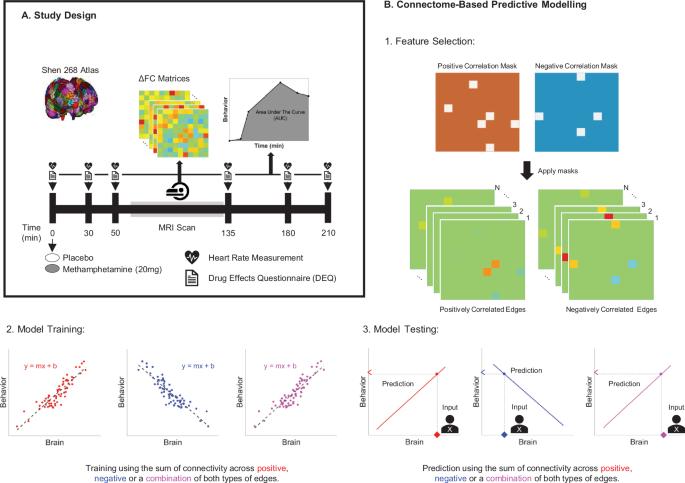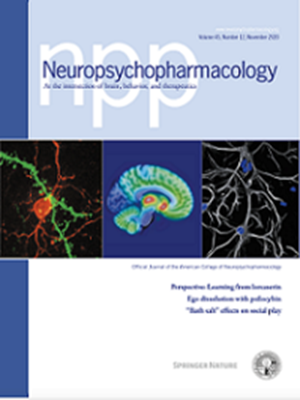基于连接体编码的急性口服甲基苯丙胺主观药物反应。
IF 6.6
1区 医学
Q1 NEUROSCIENCES
引用次数: 0
摘要
甲基苯丙胺是一种被广泛滥用的药物,长期使用会对身心健康造成严重的负面影响。对急性甲基苯丙胺主观反应的个体差异先前与未来滥用的脆弱性有关。然而,这些个体差异背后的神经机制仍然知之甚少,特别是在功能连接体水平上。采用随机、双盲、安慰剂对照、交叉研究设计(每个参与者两个阶段,总共165个阶段),从83名健康成人中获得急性甲基苯丙胺刺激后的静置状态功能连接数据,并使用五倍交叉验证生成主观反应的大脑行为预测模型。心率作为一个控制变量来评估预测模型对主观和生理影响的特异性。采用同样严格的安慰剂对照设计,使用来自22名健康成人的单独样本的数据来测试外部泛化性。基于连接体的预测模型成功地预测了主观反应的个体差异(ρ =0.25, p = 0.02),但不能预测心血管效应(ρ = 0.08, p = 0.199),主要是由感觉运动连接的个体差异驱动的。在外部复制样本中,在识别网络内的连通性和主观反应之间也观察到类似的关联(ρ = 0.37, p = 0.044)。这些发现表明,对甲基苯丙胺主观反应的个体差异反映了不同的神经效应,特别是运动/感觉网络功能的改变。这些关联是特定于主观反应的,因此不容易用药代动力学因素来解释。总之,这些发现表明,功能连接组的个体差异编码了主观甲基苯丙胺效应的差异,这可能导致对使用升级的易感性差异。本文章由计算机程序翻译,如有差异,请以英文原文为准。

Connectome-based encoding of subjective drug responses to acute oral methamphetamine
Methamphetamine is a widely abused drug, and its chronic use is associated with significant negative physical and mental health consequences. Individual differences in subjective responses to acute methamphetamine have been previously linked to vulnerability for future misuse. However, the neural mechanisms underlying these individual differences remain poorly understood, particularly at the functional connectome level. Resting state functional connectivity data following an acute methamphetamine challenge was acquired from 83 healthy adults using a randomized, double-blind, placebo-controlled, cross-over study design (two sessions per participant; 165 total sessions) and used to generate brain-behavior predictive models of subjective response using five-fold cross-validation. Heart rate served as a control variable to assess the specificity of the predictive models to subjective versus physiological effects. External generalizability was tested using data from a separate sample of 22 healthy adults acquired using a similarly rigorous placebo-controlled design. Connectome-based predictive models successfully predicted individual differences in subjective response (rho(ρ)=0.25, p = 0.02) but not cardiovascular effects (ρ = 0.08, p = 0.199), as driven by individual differences in predominantly sensorimotor connections. Similar associations between connectivity within the identified network and subjective responses were observed in the external replication sample (ρ = 0.37, p = 0.044). These findings suggest that individual differences in subjective response to methamphetamine reflect distinct neural effects, particularly alterations of motor/sensory network function. These associations are specific to subjective responses and thus cannot easily be accounted for by pharmacokinetic factors. Together these findings suggests that individual differences in the functional connectome encode for differences in subjective methamphetamine effects that may contribute to differences in susceptibility for escalation in use.
求助全文
通过发布文献求助,成功后即可免费获取论文全文。
去求助
来源期刊

Neuropsychopharmacology
医学-精神病学
CiteScore
15.00
自引率
2.60%
发文量
240
审稿时长
2 months
期刊介绍:
Neuropsychopharmacology is a reputable international scientific journal that serves as the official publication of the American College of Neuropsychopharmacology (ACNP). The journal's primary focus is on research that enhances our knowledge of the brain and behavior, with a particular emphasis on the molecular, cellular, physiological, and psychological aspects of substances that affect the central nervous system (CNS). It also aims to identify new molecular targets for the development of future drugs.
The journal prioritizes original research reports, but it also welcomes mini-reviews and perspectives, which are often solicited by the editorial office. These types of articles provide valuable insights and syntheses of current research trends and future directions in the field of neuroscience and pharmacology.
 求助内容:
求助内容: 应助结果提醒方式:
应助结果提醒方式:


